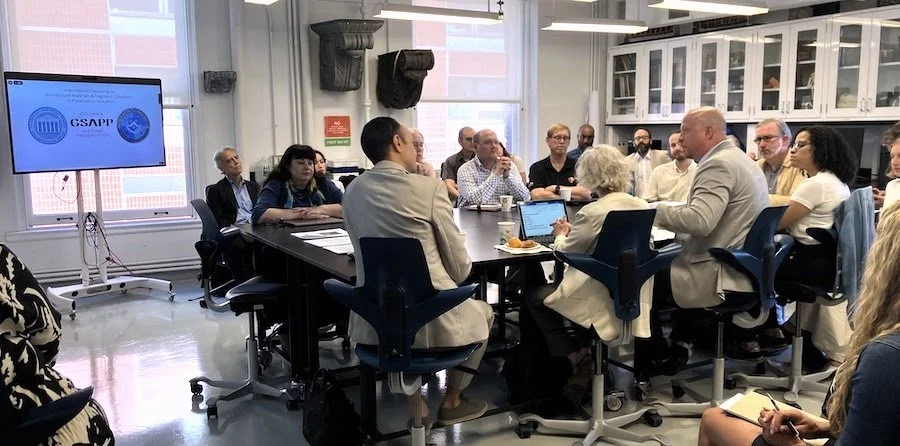Jenrette Foundation Convenes Meeting on Managing Historic Fragments in Collections Around the Country
Author: William Richards, Ph.D.
Fragments are singular teaching tools for researchers and students in historic preservation, architecture, architectural history, archaeology, chemistry, engineering, library sciences, and other disciplines—and their existence is often integral to curricula and syllabi.
The Jenrette Foundation convened directors and conservation officers from cultural and historic institutions, as well as university directors to strengthen collaboration and establish intentional collecting criteria for the 21st century.
On June 27, 2024, the Richard Hampton Jenrette Foundation convened a special meeting at Columbia University Graduate School of Architecture, Planning and Preservation (GSAPP) among the country's top institutions to focus on establishing a strategy for collecting and managing architectural fragments.
Fragments represent a broad category of cast-off elements of historic buildings including voussoirs, tiles, molding, finials; hardware such as door knobs, rebar, hinges, and nails; and decorative items such as wallpaper, paint chips, carpeting, and molded plastic furniture. They're collected by universities, nonprofits, government offices, and individuals as part of a building’s renovation, demolition, move, or transformation.
“When it comes to collections such as ours, we have to ask why it matters—asking why we save things, for what purpose, and for whom. We want to change the views of preservation collections about improving access, too, and make collections more inclusive,” said Jenrette Foundation president Benjamin Prosky. Our job as stewards is not about gatekeeping but sharing, and the Jenrette Foundation is proud to convene the right group of people to ask—and answer—the most urgent questions facing architectural collections today.”
Objectives for the day included developing intentional collecting criteria, enhancing preservation pedagogy, strengthening collaboration, establishing best practices, and promoting public engagement. Participants included directors and conservation officers from institutions such as the Historic House Trust of New York City, Colonial Williamsburg Foundation, the National Park Service, and the Oslo School of Architecture and Design, Harvard University’s Frances Loeb Library, the Getty Conservation Institute, and Columbia University’s Graduate School of Architecture, Planning, and Preservation. They represented a range of geographies, financial positions, and motivations—united by a common concern for the future of collecting amid threats and opportunities to the physical fragments they protect, interpret, and promote.
Occasionally, a fragment is the only physical evidence of a building’s existence, making it a vital resource for historic properties in their interpretive and reconstructive efforts.
“The whole issue with these rare objects is, ‘this is it,’ and so the question is about where you put fragments that are the only surviving evidence, which you don’t want to deaccession,” said Mary Jablonski, president and founder of Jablonski Building Conservation, one of the meeting’s participants, whose company maintains a collection.
Fragments are also singular teaching tools for researchers and students in historic preservation, architecture, architectural history, archaeology, chemistry, engineering, library sciences, and other disciplines—and their existence is often integral to curricula and syllabi. “You can learn things from these fragments that you cannot learn by visiting the buildings they came from today because they were taken from parts of the building that are concealed or impossible to access,” said Matthew Webster, executive director for architectural preservation and research at the Colonial Williamsburg Foundation, one of the meeting’s presenters.
The group gathered at Schermerhorn Hall at Columbia in the Preservation Technology Laboratory—the first of its kind in the U.S. and founded in 1977 by Norman Weiss, who drew on building pathology and building science courses to create a unique resource center that has been a guide for all others that have followed. Weiss' first acquisition was a piece of East Longmeadow (Massachusetts) sandstone removed from H.H. Richardson’s 1866 Church of the Unity—demolished in 1961 and whose site is a parking lot today. The Columbia lab was remodeled in 2017, and nearly one-third of GSAPP courses utilize its fragments collection in one form or another
“I think the question of why we collect is important,” Weiss told the group, “and we are constantly changing the way we look at things. We use these objects all the time and we’re learning from the history of these materials—some of them are failed materials and some were successful materials, all of them contributing to a curriculum that continues to evolve.”
One of the themes discussed, described as “the collection that isn’t seen,” dealt with the chief challenge of maintaining a library of objects with individual conservation requirements and low or no public visibility. Expressing the richness of a collection, most of which is under lock and key, can be achieved through digitization and managing a public-facing open database, yet these activities create additional administrative layers requiring expertise and funding.
Another theme was the ways in which we classify things worth keeping, from glazed Moorish tiles from the 8th century to one-of-a-kind decorative panels designed by Louis Sullivan in the 19th century to more mundane objects like sewage pipes or I-beams cast in the 20th century. All are considered to have significance for current and future researchers, yet the practical considerations of storage—especially for large and heavy iron and steel objects, or incredibly delicate objects—raise questions about square-footage to institutions starved for space and, indeed, long-term value to acquisition or management plans.
“The Jenrette Foundation has been so generous with us and it’s been a great start to this relationship,” said Jorge Otero-Pailos, Director and Professor of Historic Preservation at GSAPP. “This overlaps an ongoing project of researching the provenance of objects—especially as we’ve all inherited objects and we’re all at a critical moment to make decisions about what to reject, accept, and collect.”
The Columbia Preservation Technology Lab meeting builds on the Jenrette Foundation’s ongoing support of historic preservation education and technology around the country including Tulane University, the American College of Building Arts, Mount Vernon’s summer interns rebuilding its foundation at Mount Vernon, the 2024 Association of Preservation Technology conference in Montreal, and White House HIstorical Society interns, among other opportunities.






